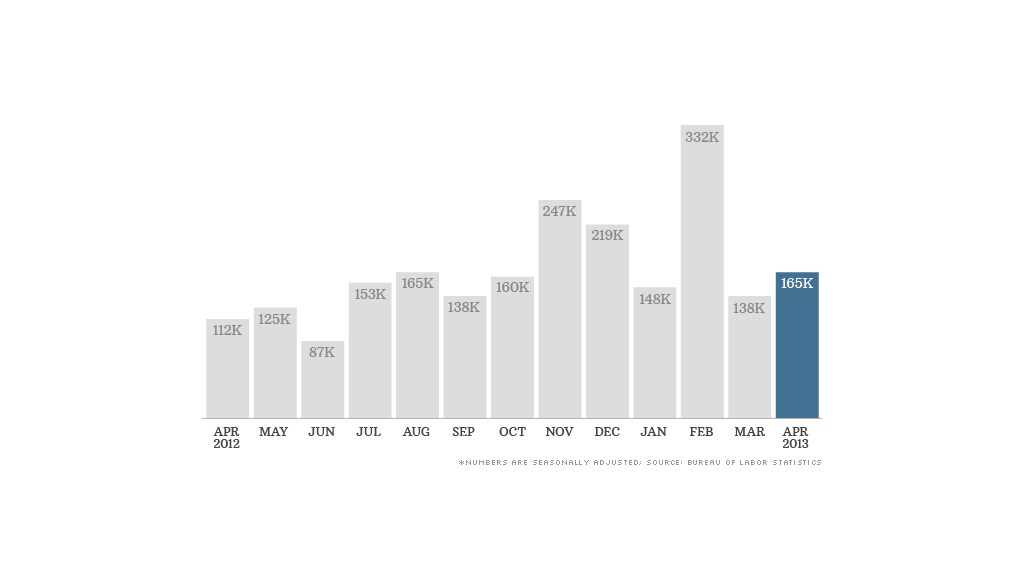
The U.S. economy seemed to be headed for a spring slowdown this year. Then the April jobs report was released Friday morning, and now some economists are doing a double-take.
The economy added 165,000 jobs in April, according to the Labor Department. That was more than the 140,000 jobs economists expected, and it marked an improvement over March.
The even bigger story, though, came from large revisions to earlier numbers. It's a common practice for the Labor Department to revise its data for the two prior months, and this time, those revisions showed an additional 114,000 jobs were added in the U.S. economy over February and March alone.
Previously, March hiring had looked particularly weak, with only 88,000 jobs added that month. Now, the Labor Department says 138,000 jobs were added in March.
February job growth, which had already looked solid, now looks even stronger. About 332,000 jobs were added in February, making it the strongest month for hiring since the Census hired temporary workers in 2010.
The report goes a long way "toward soothing fears of another spring slowdown," said Paul Ashworth, chief U.S. economist for Capital Economics.
Economists had been warning of a spring swoon for the third year in a row, this time driven largely by government spending cuts and global economic weakness. Retail sales slumped unexpectedly in March, the manufacturing sector stalled in April, and signs abroad point to a global deceleration. China's rapid economic growth has lost some steam and Europe is still mired in a recession.
But those fears eased following the report. Stocks jumped. For the first time ever, the Dow topped 15,000 and the S&P 500 climbed above 1,600.
Service jobs boom: The strongest job growth in April came from restaurants and bars, which added 38,000 jobs; temporary services, which added 31,000 jobs; and retailers, which added 29,000 jobs. On the flip side, the government is now the biggest drag on the job market. Overall, federal, state and local governments cut 11,000 jobs in April.
The bigger picture, however, remains static. About 11.7 million people remain unemployed, and the unemployment rate fell to 7.5% in April, but that's still high compared to historical levels. Before the recession hit, the unemployment rate was 4.5%.

"This is a classic 'hold-steady' report -- enough job growth to keep the unemployment rate stable but not much more," said Heidi Shierholz, an economist with the Economic Policy Institute. "In good times, this would be fine, but at a time like this, it represents an ongoing disaster."
A big question still hangs in the air about how many jobless Americans are simply not being counted in the unemployment figures. The unemployment rate only includes people who have looked for work in the prior four weeks. Workers who have given up on the job market are not counted.
Only 63.3% of the civilian population, over age 16, is either working or looking for a job. That's the lowest labor force participation rate since May 1979.
Blue-collar jobs take a hit: Over the last six years, the labor force has declined most dramatically in auto manufacturing states like Michigan, Ohio and Indiana. While some veteran workers may simply be retiring, the trend could also reflect former blue-collar jobs transforming into fewer high-skill, technical positions.
"These jobs pay more, but there aren't as many of them either," said Mark Vitner, senior economist for Wells Fargo. "In order to fill those jobs, workers may need to be retrained."
Nationwide, manufacturing hiring came to a halt in April.
Construction firms also cut 6,000 jobs. The sector had been adding jobs for the prior 10 months, fueled mainly by the housing recovery. But, as of April, job cuts by commercial firms were large enough to offset jobs added by homebuilders. Those job cuts are most likely tied to recent declines in government-funded construction projects, for example on infrastructure and schools.
Health care remained a strong sector, adding 19,000 jobs in April. Hospitals and doctors' offices hired more workers, and demand for more health care for the elderly is driving a surge in home health care services. That industry added 6,000 jobs in April. The Labor Department expects home health aide to be the fastest growing occupation in the country this decade.
How far we've come: Overall, the U.S. economy lost 8.7 million jobs in the financial crisis, and since then has added back about 6.2 million jobs.
Once you factor population growth into the mix, Shierholz estimates there is still a gap of 8.6 million jobs "missing" from the U.S. economy. If hiring keeps up at its current pace, it will take about five more years to get back to a pre-recession job market.


